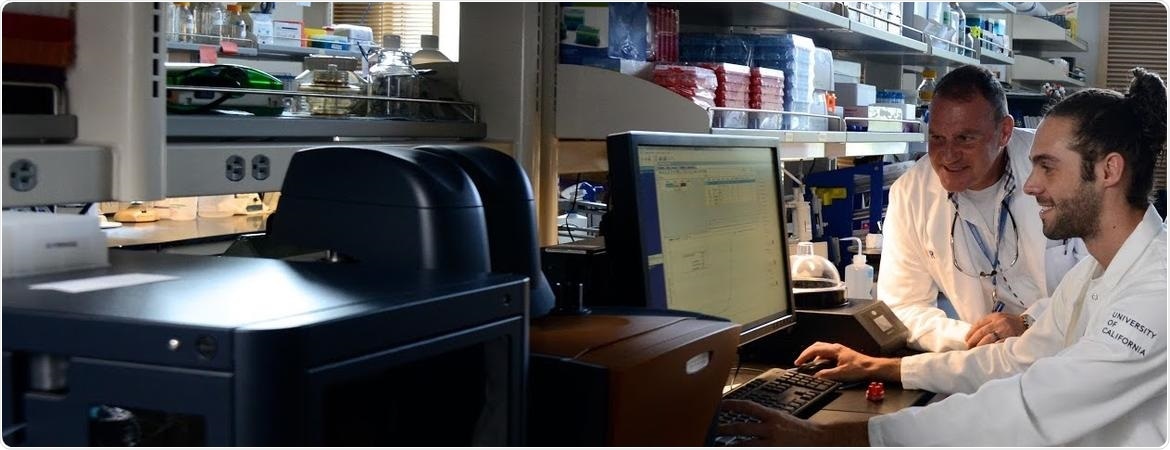How to prevent the novel coronavirus from invading a host cell in an attempt to prevent infection? A group of biomedical researchers has made a finding that provides a solution for this.

Photo shows Maurizio Pellecchia (left) and Carlo Baggio. Image Credit: Carrie Rosema.
The researchers, headed by Maurizio Pellecchia in the School of Medicine at the University of California, Riverside, have reported in the Molecules journal that two proteases, enzymes that disintegrate proteins, situated on the surface of host cells and responsible for processing the entry of viruses could be blocked.
The inhibition of proteases would prevent SARS-CoV2, the coronavirus that causes COVID-19, from penetrating the host cell. The study featured as the cover story of the journal (Volume 25, Issue 10).
Spike glycoprotein
A crucial protein known as spike glycoprotein or S-glycoprotein is present on the outer surface of coronaviruses. The S-glycoprotein is responsible for providing the usual crown-shaped structure to the coronavirus and is crucial for the entry of viral particles into host cells.
However, host cell proteases must initially process or splice this protein present on the viral surface to permit the entry of the virus into the cells.
Pellecchia’s laboratory and others have recognized that apart from a formerly identified protease known as TMPRSS2, the novel SARS-CoV2 coronavirus could also be processed by another human protease, known as furin, for the entry of the virus.
The use of the host protease furin for processing is a common mechanism of cell entry by both viral fusion proteins and certain bacterial toxins. SARS-CoV2 uses this mechanism also. The nature of the ‘proteolytic cleavage’ in its S-glycoprotein can determine whether this virus can be transmitted across species, for example from bats or camels to humans.”
Maurizio Pellecchia, Study Lead and Professor of Biomedical Sciences, University of California, Riverside
A fusion protein integrates the characteristics of more than one protein. Proteolytic cleavage is the process of breaking the peptide bonds between amino acids in a protein, resulting in cutting the protein.
The coronavirus S-glycoprotein comprises three cleavage sites that are processed by human host proteases. The actual sequence and nature of these cleavage sites, and their corresponding processing proteases, can establish the pathogenicity level and whether the virus can cross-species.
Spotlight on inhibitors
Pellecchia elaborated that the anthrax toxin, analogous to SARS-CoV2, should be processed by human furin to infect macrophages, a type of white blood cell. Pellecchia’s team used anthrax toxin as a model system and eventually identified an inhibitor of both furin and TMPRSS2 in animal and cellular models that can efficiently inhibit the entry of cells by the toxin.
The TMPRSS2 inhibitor camostat was used to recently initiate a clinical trial with COVID-19 patients.
We found, however, that camostat is a poor furin inhibitor. Our current study, therefore, calls for the development of additional protease inhibitors or inhibitor-cocktails that can simultaneously target both TMPRSS2 and furin and suppress SARS-CoV2 from entering the host cell.”
Maurizio Pellecchia, Study Lead and Professor of Biomedical Sciences, University of California, Riverside
Pellecchia added that to date, the existence of a furin cleavage site in SARS-CoV2 had been associated with an increase in pathogenicity. However, the genetic elimination of furin in cellular laboratory research failed to inhibit the entry of viruses, implying that TMPRSS2 continues to be the most relevant protease.
However, with the help of peptide sequences from SARS-CoV2 S-glycoprotein, Pellecchia’s research team has currently demonstrated that the novel mutations in this coronavirus strain resulted in increased and efficient processing of viral entry by TMPRSS2 and furin.
In other words, SARS-CoV2, unlike other less pathogenic strains, can more efficiently use both proteases, TMPRSS2 and furin, to start the invasion of host cells. While TMPRSS2 is more abundant in the lungs, furin is expressed in other organs, perhaps explaining why SARS-CoV2 is capable of invading and damaging multiple organs.”
Maurizio Pellecchia, Study Lead and Professor, Department of Biomedical Sciences, University of California, Riverside
Pellecchia’s laboratory has already identified effective and potent preclinical inhibitors of furin and proved that these inhibitors could be developed as potential therapeutics for COVID-19, perhaps along with drugs like the TMPRSS2 inhibitor, camostat.
Funding sought
“We are seeking additional funding to pursue the design and development of dual inhibitors that can simultaneously target both TMPRSS2 and furin. The funding would allow us to explore new possible effective therapeutics against COVID-19 and support studies that could have far-reaching applications to ward off possible future pandemics resulting from similar activating mutations in other viral strains,” Pellecchia concluded.
Source:
Journal reference:
Barile, E., et al. (2020) Potential Therapeutic Targeting of Coronavirus Spike Glycoprotein Priming. Molecules. doi.org/10.3390/molecules25102424.